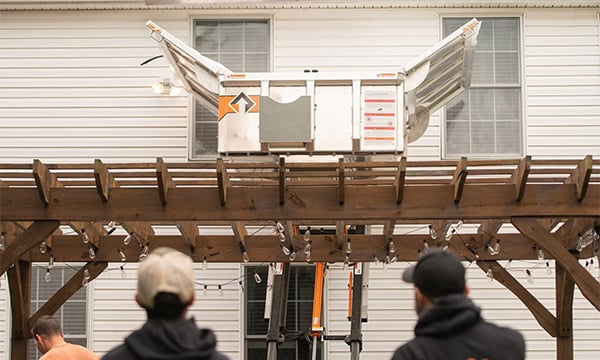Storms can damage roofs in a variety of ways. Some ways are obvious, heavy winds and hail can cause immediate, visible damage. Other ways are harder to spot, like snow and ice causing stress damage to roofs. This article will cover different ways inclement weather can damage your roof, what to do if you suspect your roof has been damaged, and why you shouldn’t wait to repair a damaged roof.
The most common source of roof storm damage comes from severe weather events with high speed winds and hail. High winds can lift shingles and create gaps in your roof that leave it vulnerable to water getting through. Winds can also carry debris that may impact and puncture your roof. Tree limbs and branches can fracture roofs during particularly heavy storms. Hailstones can crack asphalt shingles or split wooden shakes. Extreme weather events like hurricanes, tornadoes, and derechos can cause even more significant damage.
Heavy winter storms and blizzards can also cause damage. Excessive weight from accumulated snow can cause roofs to sag and even collapse. The process of thawing and refreezing can create ice dams and further stress shingles. Standing water can also seep through cracks and create leaks.
As soon as the storm has passed and it is safe to do so, it's essential to inspect the roof for any visible damage. From the ground level, you can look for telltale signs of damage like missing or torn shingles or any other displaced material. Inside of your house, look for signs of water leaks or water stains. Peeling paint and discoloration may also point to a potential leak. If you suspect damage, schedule a professional inspection with a roofing contractor. Once an inspection has assessed the damage, you can file a homeowner’s insurance claim.
There are various reasons not to hold off repairing your roof if it has been damaged. Storm damage can create openings in the roof and allowing water into your home can cause water damage, mold growth, and water damage can lead to future structural issues. A damaged roof can lead to leaks that damage ceilings, walls, and insulation. Many insurance policies require prompt reporting of storm damage. If a roof isn’t repaired in a timely fashion, it may result in less compensation or a loss of coverage. Finally, promptly addressing roof repair can extend the lifespan of your roof.
Roofing crews from coast to coast use the self-driving Equipter 4000 liftable trailer. The Equipter 4000 leads to quicker, more efficient roof repair and replacement and using its box to catch shingles and nails leaves yards free of debris. When inquiring about roof repair, ask if the roofing company uses the Equipter 4000.